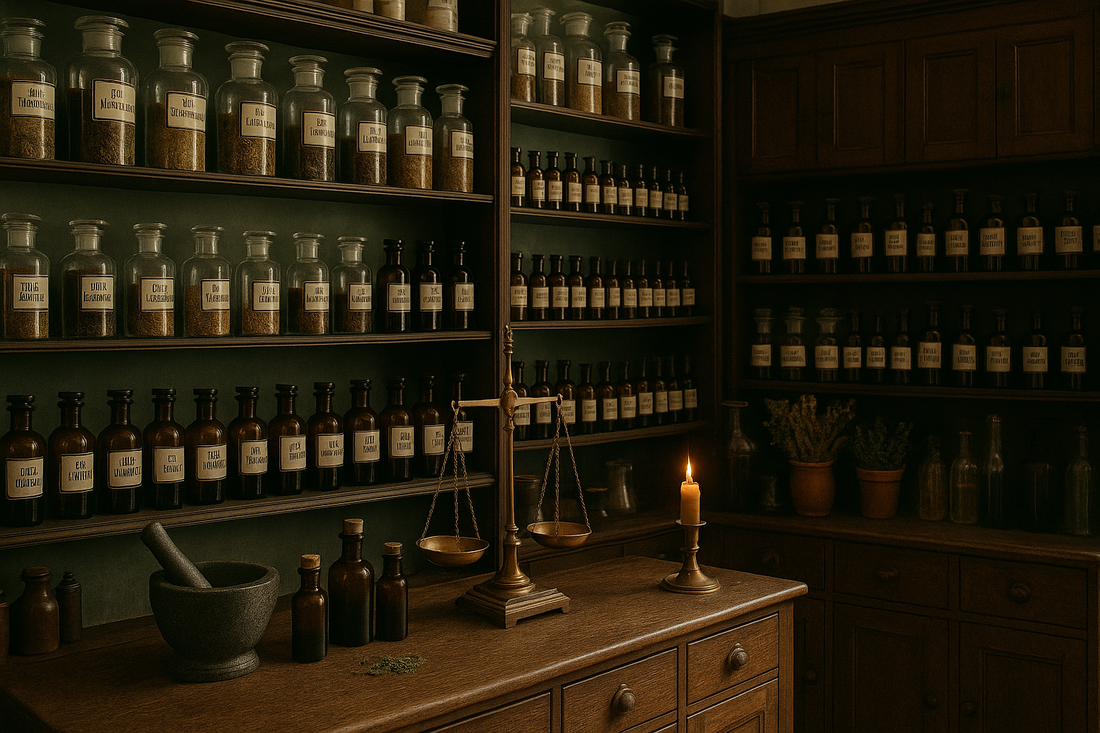
Old-World Apothecary Remedies for Modern Self-Care
Rooted wisdom for a world that’s always rushing.

Step inside the old apothecary.
The shelves are lined with amber glass jars, each brimming with herbs and botanicals — lavender buds, rose petals, crushed calendula blooms. The air hums with the quiet scent of earth and oil, wax and wood. Here, everything slows down. Each remedy is made by hand, with patience and purpose.
Centuries ago, the apothecary’s craft was part science, part ritual. These healers blended knowledge from nature — leaves, flowers, roots, and resins — into tonics, balms, and elixirs meant to nurture both body and spirit. And though the world has changed, that timeless desire to care for ourselves with intention has not.
Today, the art of the old-world apothecary is finding new life in modern self-care.
🪶 The Wisdom We Almost Forgot
Before lab-made formulas and fluorescent aisles, there were herbalists and apothecaries. They worked by candlelight, guided by intuition, experience, and the slow study of nature’s rhythms. Their work was grounded in observation — a soothing tea for restlessness, a salve for dry, weathered hands, a tonic for winter’s chill.
Modern wellness often circles back to this simplicity. In returning to herbal remedies, we’re not dismissing science; we’re honoring what came before it — the knowledge that balance, rest, and nourishment start with the earth.

🌸 Timeless Botanicals Still at Work Today
Lavender — The old remedy for restless hearts and sleepless nights. Still today, its oil calms the nervous system and softens tension. A few drops in a warm bath or a bedside diffuser can work quiet miracles.
Calendula — Known once as “sun bride,” this golden flower was steeped into healing salves. Its gentle, anti-inflammatory nature makes it a skin-soothing favorite even now, especially for dryness, irritation, and minor wounds.
Comfrey — Called “knitbone” in centuries past, comfrey was a trusted herb for supporting the body’s natural repair process. Rich in allantoin, it was used to comfort sore muscles and restore weathered skin — a botanical symbol of resilience that still finds its place in modern balms and body care.
Rosemary — The herb of remembrance and clarity. Old herbal texts praised it for improving circulation and sharpening focus. Modern studies now echo what ancient hands already knew.
🕯️ Bringing the Apothecary Home
You don’t need a stone-floored shop or wooden drawers filled with herbs to live like an apothecary.
You simply need presence — and a few plants that speak to your needs.
- Brew a ritual tea: Steep chamomile, mint, or rose petals as a daily pause.
- Create a botanical soak: Mix Epsom salts with dried calendula and lavender for a grounding bath.
- Massage with intention: A few drops of jojoba or grapeseed oil infused with essential oils becomes a self-care ritual rather than a routine.
- Tend to your senses: Burn a natural candle, apply a handcrafted balm, or mist your pillow with lavender — simple gestures that connect you to the lineage of care.
✨ Why It Still Matters
Old-world remedies remind us that wellness isn’t found in speed — it’s found in ritual.
When we take time to steep, stir, and apply with care, we honor a rhythm our bodies remember. In the apothecary’s way, healing is never rushed. It’s intentional, rooted, and beautifully human.
Perhaps that’s the true medicine — not just the herbs, but the act of remembering how to slow down and listen.
🌿 A Closing Reflection
The modern world tells us to hurry; the old apothecary whispers, breathe.
Somewhere between those two lies balance — a place where tradition meets presence, and where caring for ourselves feels sacred again.
“Old-World Remedies for Modern Life.”
— From the Apothecary
